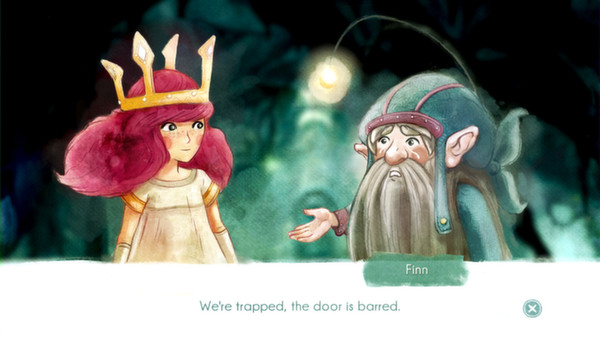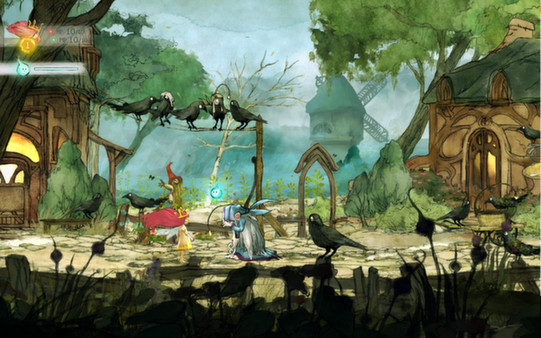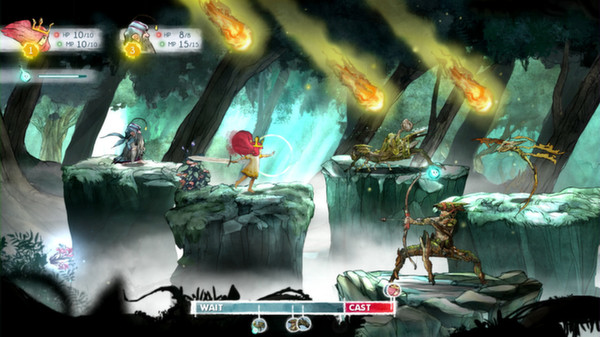Along with the upcoming Valiant Hearts: The Great War, Child of Light is a smaller, $15 downloadable “artsy” game designed to feel like an indie title without actually being indie by any stretch of the definition. Developed by Ubisoft using the UbiArt Framework created for the recent Rayman games, it is one of many recent attempts by mainstream, AAA publishers to get a slice of the indie pie that has been getting quite popular on PC and digital stores across all platforms. Child of Light contains many of the ingredients that are often found in hit indie titles, like a charming story, gorgeous visuals, and rather unique ideas and mechanics, but I feel that Ubisoft still largely missed the point.
From the beautiful watercolor-inspired visuals, to the story and verse-based dialogue, Child of Light heavily invokes the feeling of a child’s fairytale book. Aurora, the young daughter of a duke, falls asleep due to an unknown illness and awakes in the magical realm of Lemuria. This fantastical world has fallen under the spell of a dark queen, and Aurora must gather together a charming band of misfits if she is to defeat the queen and find a way back to her own world. The story gets surprisingly dark at times, and leaves the nature of Lemuria open for multiple interpretations. Dialogue and collectible poems called Confessions hint at the world being everything from a dream to the afterlife, and I’m sure it will cause much debate on forums all across the Internet.
Beyond the themes and mystery of Lemuria’s nature and origins, the story is largely predictable, but still pretty well presented and engaging. Across this roughly 10 hour experience, Child of Light is filled with colorful character design and gorgeous environments to explore, and Aurora’s gaggle of oddball adventurers includes some interesting party members. Some members of the party include a large and rather beastly-looking disgraced warrior, a cowardly gnome sorcerer, a pair of incompetent jesters that aren’t good enough at their chosen professions to make it as a big circus act, and an expert archer from a race of anthropomorphic capitalist mice that constantly obsess over the current state of the stock market. Interaction with the members of your party is a bit few and far between, but the characters still manage to go through their own development arcs.


On the other hand, what really doesn’t work about the story is the verse-driven dialogue. Most of it ranges from pretty mediocre to downright cringe-inducing, with only a few nuggets of genuinely good poetry. The development team’s insistence on making everything rhyme leads to many not-quite rhymes and mangled verses. I understand that they were trying to further evoke the storybook feel of the setting, but the rhymes often just fall flat. In many places the dialogue would have worked out so much better if it wasn’t comprised entirely of verse.
Aurora gains the ability to fly very early on, opening up new avenues of exploration in the game’s often maze-like levels. Each area is full of chests and consumables used to permanently increase a character’s stats, many of which are hidden in hard to reach areas or locked behind puzzles. Following you around is a little blue firefly that can be independently controlled with the right thumbstick or mouse. He is required to reach some hidden loot and can light your way in dark areas, temporarily blind roaming enemy mobs, or collect “wishes” that regenerate the party’s mana and health. In a nice asymmetric multiplayer feature he can be controlled by a second player, a perfect way for a significant other who is less experienced with games to enjoy the title with you.
The game’s combat is a fun twist on the turn-based battles found in a more traditional JRPG. It reminds me of Grandia in many ways, with its focus on timing, slows, and cancels. The bottom of the screen contains a bar with character and enemy icons on it that move towards a red “action” zone. Once a character gets to the action zone, they get to choose their action for the “turn.” However, once an ability is queued up in this zone, that character is susceptible to having their action interrupted by any attack that hits them, pushing them back on the timeline and delaying their ability to attack or use items.

This makes the combat all about timing your attacks just right so that they connect, or better yet interrupt an enemy’s attack. Many characters have attacks that slow down enemies, knock them backwards on the bar, or outright paralysis them for a few seconds. Aurora’s firefly companion has his uses in combat as well, and can heal your characters, slow enemies, or collect wishes that regenerate health and mana. A pretty standard elemental rock-paper-scissors system also exists, and works more or less exactly as one would expect. A fire-based enemy will take extra damage from water-based attacks, dark enemies are susceptible to light magic, and so on. It isn’t as developed as many other RPGs, and the number of different elements are pretty limited, but it gets the job done well enough.
The combat is definitely one of Child of Light‘s strongest features. It’s fun and unique while still being fairly familiar and easy to pickup for fans of more traditional RPGs. With that said, experienced RPG fans should ignore the Normal (now renamed Casual) difficulty setting altogether and go straight into Hard. I made the mistake of playing on Normal before the setting was renamed and found the combat to be entirely too easy. Between carefully timed interrupts, strategic use of time-delaying abilities, and your firefly’s slowing powers, you can easily beat many enemies without taking any damage. I finished the whole game without dying once, and a quick look at forums reveals that many players had the same experience. It certainly doesn’t help that even a minimal amount of exploration will have you drowning in more health potions than you could ever possibly use, and many of these health potions are full 100% heals. I’ve heard that the second difficulty, the Hard mode, is actually quite challenging and provides a much more rewarding experience for RPG veterans.
Unfortunately, one place where the game falls short is in the equipment system and skill trees. Equipment is based around magical gems called oculi. Each character has three oculi slots, and each oculi provides a different benefit depending on which slot it is equipped in. An oculi that adds fire elemental damage to attacks in the first slot might instead grant fire resistance when in the second slot. Oculi can also be combined in different ways inside of a crafting menu to create more powerful oculi. My issue with the system is that there just aren’t all that many types of oculi, and with only three slots per character your equipment options are fairly limited. I fully get what they were going for with the system, but I prefer much deeper and more complex equipment and crafting systems in my RPGs.
The skill trees aren’t much better. While the skill trees might look large and interesting at first, you quickly realize that they are actually really bland and simplistic. The vast majority of “skills” are actually just things like +1 to Strength or +1 to Magic Resistance, and the genuine ability upgrades are usually focused on just improving abilities the characters start with. The next upgrade to a character’s fire spell will normally just slightly increase the damage. The only drastic changes are when you unlock a slower, more expensive version of an existing spell or ability that targets all enemies or all allies. A character may only get one or two actually new abilities from their skill tree, with most being very linear upgrades to the small pool of attacks they had when the character joined your party.

Ultimately, Child of Light feels exactly like what you would get from a AAA publisher trying to replicate an “indie-like feel.” The visuals are gorgeous, and the core mechanics are sound, but there is just a lack of depth and nuance in the more secondary mechanics. I really enjoyed the core mechanics involved in the combat, but can’t help but feel that the skill trees, oculi system, and just number of special attacks characters have in general were underdeveloped and a little rushed. The first few hours had me captivated with child-like wonder at the enchanting setting and visuals with a genuinely fun combat system, but the further I got into the game the more I started asking “Is this all there is to it?”
Make no mistake, I still enjoyed Child of Light and recommend it to anyone looking for a solid little bite-sized JRPG-inspired experience. I think I just got a little too hyped by the idea of Ubisoft experimenting with smaller, less traditional games. There is a lot to like in Child of Light, most notably the combat system and interesting character designs, but I just wanted to see a bit more depth in the skill trees and equipment systems. In any case, I still welcome Child of Light and the upcoming Valiant Hearts as games that the industry really needs. I hope these two games convince other major publishers to experiment with and see the usefulness in smaller $15 titles with slightly riskier ideas and mechanics. You can currently find Child of Light on Steam and Ubisoft’s uPlay store for the PC, and on Xbox Live and PSN for both current and previous generation consoles. I may not have loved it quite as much as I really wanted to, but still encourage anyone interested in the title to give it a shot, if only to show to publishers that not every game needs to be a big budget action game at a $60 + $40 season pass price point.
Frank Streva is an aspiring game designer that currently just rambles about indie games.
